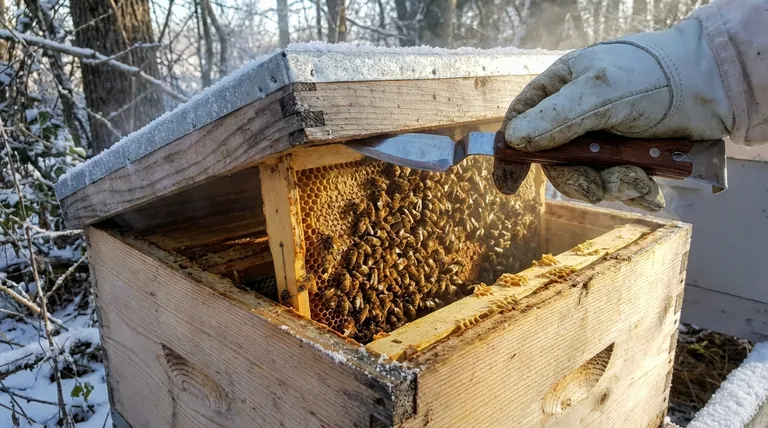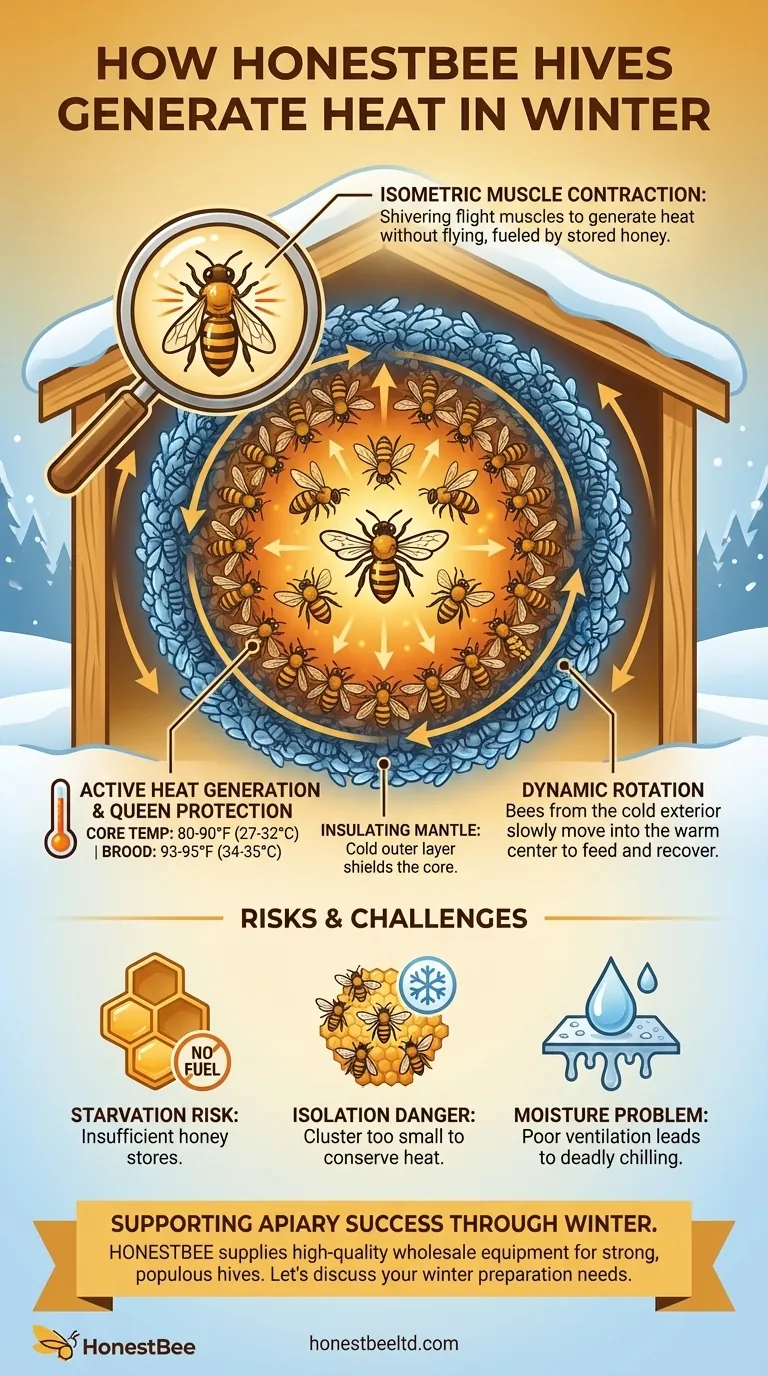To survive the cold, honey bees employ a sophisticated system of collective behavior and individual physiology. They generate heat not with an internal furnace, but by vibrating their powerful flight muscles without moving their wings. This muscular activity, combined with huddling together in a tight ball, allows the colony to maintain a life-sustaining temperature at its core, even when the air outside is freezing.
The survival of a honey bee colony through winter is not a passive act of endurance. It is an active process of thermal engineering, where the bees function as a single, coordinated "superorganism" to create and conserve heat, fueled entirely by their stored honey.

The Winter Cluster: A Living Furnace
The primary survival strategy is the formation of the winter cluster. This is not a random huddle, but a highly organized structure designed for maximum thermal efficiency.
The Core Mechanism: Isometric Muscle Contraction
The heat itself is generated by individual bees. They anchor their wings but engage their massive flight muscles, causing rapid vibrations, or shivers. This isometric contraction converts the chemical energy stored in honey directly into heat without producing flight.
The Structure: An Insulating Mantle
The cluster forms a tight ball of bees. The outer layer of bees is densely packed, creating an insulating mantle that is cold to the touch. This layer shields the bees in the interior, which are more loosely spaced and actively generating heat.
The Fuel Source: Honey as Liquid Energy
This intense muscular activity requires a tremendous amount of energy. The colony's entire fuel supply is the honey they stored during the summer and fall. As winter progresses, the cluster slowly moves upwards through the hive, consuming these honey stores to power their continuous heat generation.
Regulating the Hive's Microclimate
The goal of this effort is to create a stable microclimate within the cluster, regardless of the external temperature. The bees are remarkably precise in this task.
Protecting the Queen
The single most important individual in the colony is the queen. She is always located at the warmest part of the cluster, its center, ensuring her survival and readiness for the upcoming season.
The Critical Core Temperature
The bees work to maintain the center of the cluster at a stable temperature, typically between 80-90°F (27-32°C). This becomes even more critical around January, when the queen begins to lay her first eggs. The brood must be kept at a constant 93-95°F (34-35°C) to develop properly.
Dynamic Rotation: Sharing the Burden
Bees on the cold, outer mantle do not simply perish. There is a slow but constant rotation, where bees from the exterior move into the warm interior to feed and recover, and bees from the center cycle outwards, taking their turn on the insulating layer.
Understanding the Trade-offs and Risks
This survival strategy is effective but metabolically expensive and carries significant risks. A colony's winter survival is never guaranteed.
The Risk of Starvation
The most immediate danger is running out of fuel. If a colony's honey stores are insufficient for the length and severity of the winter, they will be unable to generate heat and will freeze. A colder winter means more fuel is burned.
The Danger of Isolation
The efficiency of the cluster depends on its size. A small colony has a larger surface-area-to-volume ratio and loses heat much faster. Even with adequate honey, a population that is too small cannot form a large enough cluster to survive deep cold.
The Moisture Problem
Metabolizing honey produces two byproducts: heat and water vapor. While heat is the goal, the water vapor can be deadly. If the hive is not ventilated properly, this moisture can condense on cold surfaces, drip back onto the cluster, and chill the bees, causing them to die.
Applying This Understanding
Understanding how a colony generates heat is key to appreciating its complex biology and, for beekeepers, ensuring its survival.
- If you're simply fascinated by nature: Recognize that a honey bee colony acts as a single "superorganism" to survive conditions no individual bee could.
- If you're a beekeeper preparing for winter: Your two main priorities are to ensure your colonies have ample honey stores and a large enough population to form a thermally efficient cluster.
- If you're studying biology: The key mechanism is isometric muscle contraction, a perfect example of repurposing an existing biological system (flight) for a new function (thermoregulation).
By integrating individual physiology with collective behavior, the honey bee colony engineers its own survival against the harsh reality of winter.
Summary Table:
| Key Element | Function in Winter Survival |
|---|---|
| Isometric Contraction | Bees vibrate flight muscles to generate heat without flying. |
| Winter Cluster | A tight ball of bees that acts as a living furnace. |
| Insulating Mantle | Outer layer of bees conserves heat for the inner core. |
| Honey Stores | Fuel source converted into energy for heat production. |
| Core Temperature | Maintained at 80-90°F (27-32°C) to protect the queen and brood. |
Ensure your apiary is prepared for winter with the right supplies. The success of a winter cluster depends on strong colonies with ample resources. HONESTBEE supplies commercial apiaries and beekeeping equipment distributors with the high-quality, wholesale-focused equipment and supplies needed to support healthy, populous hives. From hive components to feeding systems, we provide the tools for beekeepers to foster robust colonies capable of effective thermoregulation.
Let's discuss your winter preparation needs. Contact our expert team today to get the reliable equipment that supports colony survival and your operation's success.
Visual Guide

Related Products
- HONESTBEE Premium Italian Style Hive Tool with Hardwood Handle
- HONESTBEE Advanced Ergonomic Stainless Steel Hive Tool for Beekeeping
- Wholesales Dadant Size Wooden Bee Hives for Beekeeping
- Professional Galvanized Hive Strap with Secure Locking Buckle for Beekeeping
- White Beekeeping Protective Suit and Hat with Fencing Veil for Beekeepers
People Also Ask
- What are the benefits of a multi-functional hive tool? Streamline Your Apiary Workflow with One Tool
- How is a hive tool used for scraping and cleaning? Master Hive Maintenance for a Healthy Colony
- What is a hive tool and why is it important in beekeeping? The Essential Key to Hive Management
- What are some common uses of a hive tool? Essential Multi-Purpose Tool for Every Beekeeper
- How should beekeepers handle bees when using a hive tool? Master Calm, Deliberate Techniques



















